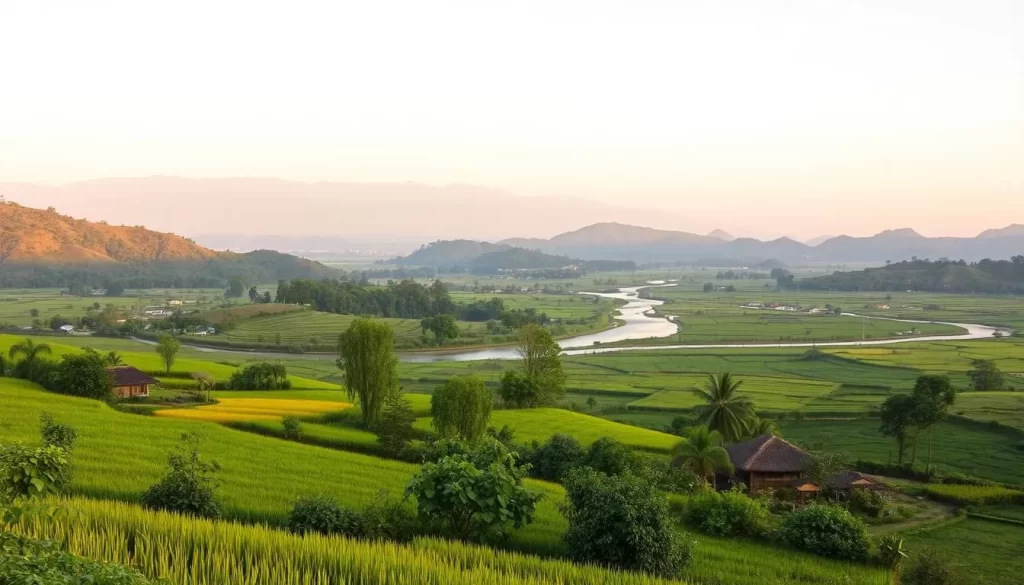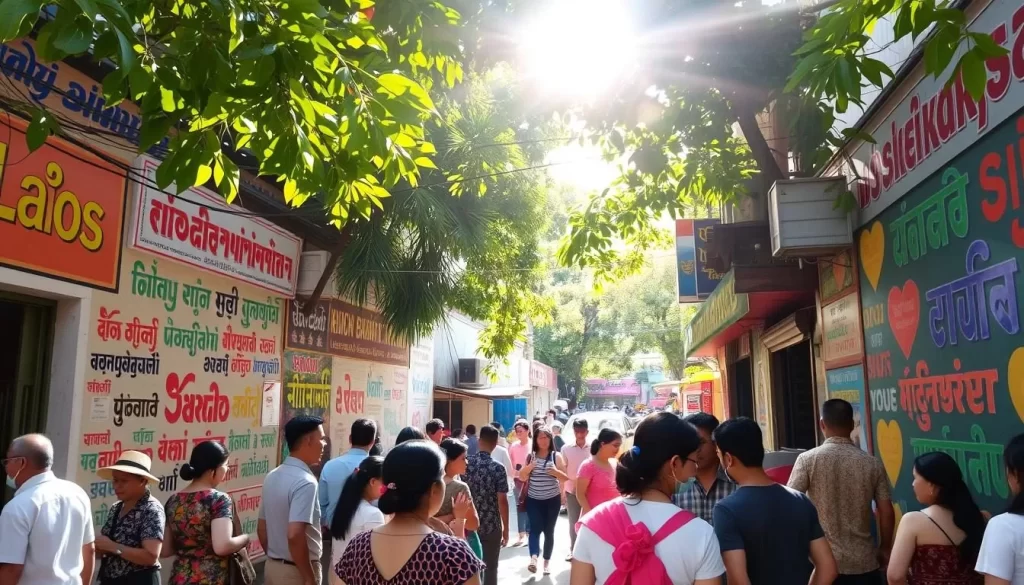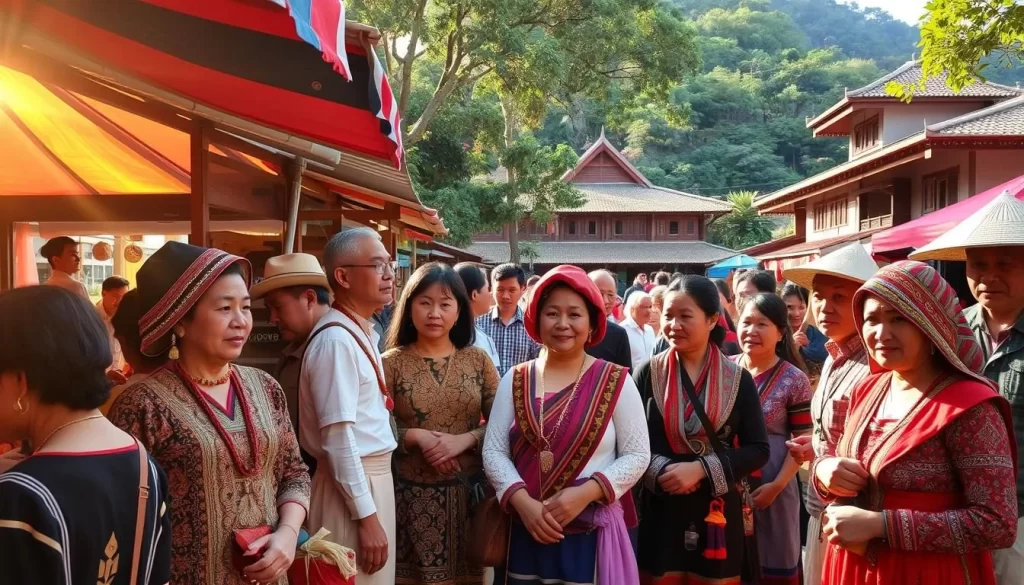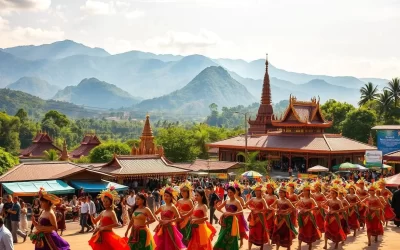When you visit Laos, you step into a country where language is a bridge to its vibrant culture. With over 80 recorded languages, this nation is a treasure trove of linguistic heritage. The official language, Lao, is spoken by a majority, but the community thrives on the richness of minority and foreign languages.
Lao, with its unique dialects and tones, is the heart of communication here. Yet, you’ll also hear the sounds of various ethnic groups, each adding their own vocabulary and phrases to the mix. In urban areas, foreign languages like English and French are increasingly common, making it easier for travelers to connect.
Understanding the language of a place can transform your journey. It opens doors to deeper connections with the community and enriches your experience. Dive into the linguistic tapestry of Laos, and discover how words and tones weave together to tell the story of this fascinating country.
An Introduction to Laos’ Linguistic Landscape
Exploring the linguistic landscape of this Southeast Asian nation reveals a tapestry of dialects and tones. Here, language is more than just a tool for communication—it’s a reflection of culture and heritage. With over 80 recorded forms of speech, this region is a hub of linguistic diversity.

Cultural Diversity and Multilingualism
The community thrives on the richness of its many tongues. From the official language to indigenous dialects, each group adds its unique vocabulary and pronunciation. For instance, the Khmu and Hmong languages are widely spoken by their respective ethnic groups.
Multilingualism is a way of life here. You’ll hear foreign languages like English and French in urban areas, making it easier for travelers to connect. This blend of traditional and modern sounds creates a vibrant linguistic environment.
The Role of Language in Travel and Communication
Understanding even basic phrases can transform your journey. It helps you connect with locals and gain deeper insight into their way of life. For example, fluency in the local tongue enhances interactions in sectors like tourism and mining.
Language also plays a key role in daily life, fostering community bonds. Whether you’re exploring rural areas or bustling cities, the words you hear tell the story of this fascinating place. Dive into its linguistic richness, and you’ll discover a world of culture and connection.
Exploring the Official Language: Lao
The Lao language, with its rich history and unique features, is a cornerstone of cultural identity. Spoken by millions, it is the official language of its homeland and a vital part of daily life. Its tonal system and evolving alphabet make it a fascinating subject for language enthusiasts and travelers alike.

Tonal System and Dialects
One of the most distinctive aspects of the Lao language is its tonal nature. The Vientiane dialect, for example, features six tones: low, mid, high, rising, high falling, and low falling. Each tone can change the meaning of a word, making pronunciation crucial for clear communication.
Dialects vary across regions, adding to the linguistic richness. These variations reflect the diverse cultural tapestry of the area. Whether you’re in urban centers or rural villages, the tones and dialects you hear tell a story of heritage and connection.
The Evolution of the Lao Alphabet
The Lao alphabet has a fascinating history. Derived from ancient Brahmic scripts, it evolved over centuries, influenced by Khmer and Mon writing systems. Today, it consists of 33 consonants and 28 vowels, forming a systematic and accessible structure for learners.
Understanding the alphabet’s development offers insight into the region’s cultural and historical transformations. Its Brahmic roots are evident in the script’s curves and symbols, which are both functional and artistic.
| Feature | Details |
|---|---|
| Tones | Six tones in the Vientiane dialect |
| Consonants | 33 symbols |
| Vowels | 28 sounds |
| Influences | Brahmic, Khmer, and Mon scripts |
For travelers, mastering basic phrases and understanding the tonal system can enhance your experience. Resources like video tutorials provide valuable practice for pronunciation and tone recognition. Dive into the linguistic richness of Lao, and you’ll gain a deeper appreciation for its culture and heritage.
Laos: Official and widely spoken languages
Language in this Southeast Asian nation reflects its cultural diversity and regional uniqueness. From the bustling streets of Vientiane to the serene villages in the north, the way people speak varies significantly. The Vientiane dialect, for instance, is the most widely understood, featuring six tones, including high falling and low falling.
In rural areas, you’ll encounter distinct dialects tied to specific ethnic groups. For example, the Khmu and Hmong communities use their own vocabulary and pronunciation, adding layers to the linguistic landscape. These regional differences highlight the nation’s rich heritage and the role of language in daily life.

Urban centers, on the other hand, showcase a blend of traditional and modern communication. Here, the influence of foreign tongues like English and French is more pronounced, especially in education and business. This mix creates a dynamic environment where culture and globalization intersect.
Impact on National Identity and Communication
Language plays a vital role in shaping national identity. Despite regional variations, the Lao alphabet and grammar provide a common framework that unites the community. This shared foundation fosters a sense of belonging among diverse groups.
In education and government, the official language serves as a unifying force. It ensures clarity in communication and reinforces national pride. For instance, nearly 35% of students are instructed in French, blending local and global influences.
Language also strengthens daily connections. Whether in markets or schools, the words people use reflect their shared history and values. This linguistic bond is a testament to the nation’s resilience and unity.
| Region | Dialect Features |
|---|---|
| Vientiane | Six tones, including high falling and low falling |
| Northern Villages | Distinct vocabulary tied to ethnic groups |
| Urban Centers | Blend of traditional and foreign languages |
Understanding these regional nuances offers deeper insight into the nation’s identity. For more on the linguistic diversity of this region, explore this detailed guide.
Diversity of Minority and Foreign Languages in Laos
The linguistic diversity of this Southeast Asian nation is a testament to its rich cultural heritage. Beyond the official language, the community thrives on the vibrant use of minority languages and foreign languages. This blend creates a unique linguistic tapestry that reflects the nation’s history and development.

Minority Languages: Khmu and Hmong
Khmu, spoken by around 500,000 people, is the second most popular language in the region. It is a vital part of the Khmu ethnic group’s identity, preserving their traditions and culture. Similarly, the Hmong language, divided into dialects like Hmong Daw, plays a crucial role in maintaining the heritage of the Hmong community.
These minority languages are not just tools for communication but also symbols of resilience. They connect people to their roots and foster a sense of belonging within their group.
Foreign Languages: English and French in Urban Settings
In urban areas, foreign languages like English and French are increasingly prominent. About 35% of students learn French, a legacy of the colonial era. English, on the other hand, is gaining traction in business and tourism, making it easier for travelers to navigate and connect with locals.
For visitors, knowing basic phrases in the local tongue can enhance interactions. Resources like video tutorials are invaluable for learning pronunciation and tone. This blend of traditional and modern languages illustrates the nation’s dynamic balance between heritage and globalization.
This linguistic diversity strengthens national identity and opens doors for international engagement. To explore more about the ethnic groups and their languages, visit this detailed guide.
Conclusion
Language is the heartbeat of a nation, connecting its people and culture. In this vibrant country, the official language serves as a unifying force, while minority languages and foreign languages enrich its social tapestry. This linguistic diversity fosters effective communication and strengthens community bonds.
Understanding the technical aspects, such as tone and pronunciation, is key for travelers and language enthusiasts. Learning even a few phrases can make a significant difference during your visit. The balance between tradition and modernization is evident in the ongoing development of language in business, education, and daily life.
For further insight, explore resources like this detailed guide or consider language immersion programs. Dive into the linguistic richness, and you’ll discover a world of culture and connection. Language is not just a tool for communication—it’s a gateway to understanding a country’s unique identity.
The above is subject to change.
Check back often to TRAVEL.COM for the latest travel tips and deals.
Here are some Tours & Sightseeing suggestions that might pique your interests!




